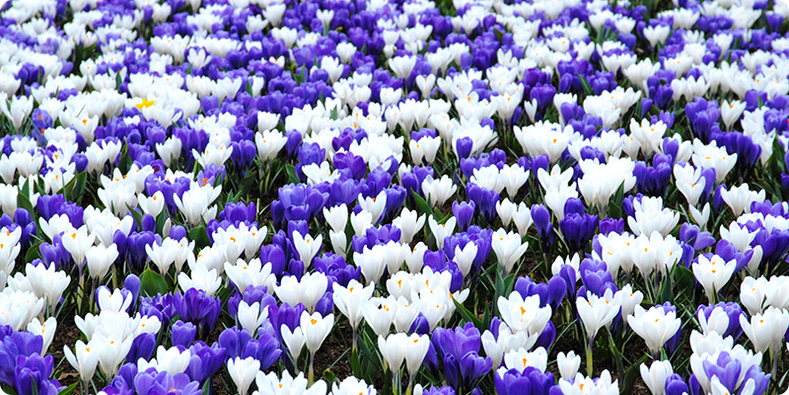Crocus
Tulips, narcissi, hyacinths, snowdrops…. there are so many beautiful flower bulbs, and they all have their own charm and characteristics. In this blog series we would like to introduce you to a variety of them, helping you to make the best choices for your garden and grow the spring display of your dreams!
Spring’s First Bright Color
While the year’s earliest bulbs opt to blend in with the colors of winter – white and light blue, crocus is one of the first early bulbs to bring a real pop of color to your garden. Joyful yellow, bluish purple, tender lilac, and even an exciting orange shade. This happy spring bulb is hardy in USDA zones 4-8 and looks best when mass planted.

Plant Passport
- Height
Crocuses measure between 4-5 inches, depending on the variety.
- Fragrance
Crocus flowers have a lovely fragrance, making it attractive to humans, but also to bees & butterflies. So the more crocuses you plant, the more you help nature.
- Color
Crocuses come in a large variety of colors. From innocent white to happy yellow and orange, and from soft lilac to deep purple.
- Bloom time
Depending on where you live, crocus blooms from late winter to early spring.
- Longevity
Once you plant crocus, they will come back every spring, making them perennial flower bulbs. And since crocus is a naturalizing bulb, you’ll get a few extra every year as well.
- Different types
Though they come in a range of colors, most crocuses are very similar, with only slight differences in height. However, there is one very special exception, the crocus Sativus or saffron crocus. Saffron, the yellow spice which has been used for millennia to give flavor and color to food, actually comes from the inside of this crocus variety, which doesn’t grow in spring, but in the fall. DutchGrown is proud to be carrying this exciting bulb, which is the perfect gift for the foodie or amateur chef in your life.
- Planting
When the leaves are turning and the soil is cooling down to about 65 F, the time has come to start planting your crocus bulbs. Find a place in your garden that has full sun or partial shade, making sure the soil there is well draining. Consider planting crocuses on your lawn where they can form carpets, or mass-plant them in the front of flower beds along the edge. Plant crocus 3 inch deep, with their pointy ends up, then water well. If you live in a drier climate, occasionally water them throughout the fall, but make sure not to waterlog the soil. Cover the beds with mulch before the winter, removing it in late February, so the crocus shoots can grow upward. If you have crocuses growing in your lawn in mid-Spring, don’t mow until their leaves have died down.
- Forcing
Forcing crocuses is an ideal way to bring a bit of nature indoors. While you can force crocuses in soil, a very elegant alternative is to force them in water. First you want to give the bulbs the cooling period necessary for them to bloom later on, about 12 weeks. Put the bulbs inside a paper bag, and place them in your refrigerator – though not together with fruit, as the gases from the fruit will interfere with the flower development. Once the chilling period is over, find a vase and fill the bottom with pebbles or decorative glass beads, placing the bulbs on top of them, pointy side up. Add just enough water, so it almost touches the underside of the bulbs. Keep the vase in a room with bright but indirect light, and watch the roots form. When necessary, add water to make sure the water level stays the same. Once leaves and stems are forming, move the vase to a lighter room with temperatures of at least 65 F. Most bulbs will flower 2 to 3 weeks after their chilling period.
- Container Planting
Crocuses look wonderful in wooden boxes or wicker baskets, as long as you make sure there are ways for water to drain out. Plant the crocus bulbs about 2 inches down in the container, closely together but not touching, with their pointy ends up. Cover them with about 1 inch of potting soil and water well after planting, checking every now and then throughout the fall to make sure the soil doesn’t get too dry. Place the container in a spot that will get full sun or partial shade in spring, and when the birds start singing, you’ll be rewarded with a joyful display of color.
- Pricing
When you order a smaller amount, most crocus bulbs cost around $0.38 / bulb, with discounts going up to 40% when you buy larger quantities. If you want something truly special though, the sought-after crocus Sativus starts at $0.62 / bulb.
- Combinations
Purple crocuses like Remembrance, will look amazing together with an early tulip like Stresa or the lily-like tulip Showwinner
First Color First Choice
Nothing will put a smile on your face like being greeted by a sea of happy little crocuses. Creating your own garden full of colorful joy has never been easier. Simply go to our website and choose the crocuses that speak to you, and we’ll deliver our high quality first-choice bulbs to your house as soon as planting season begins.
